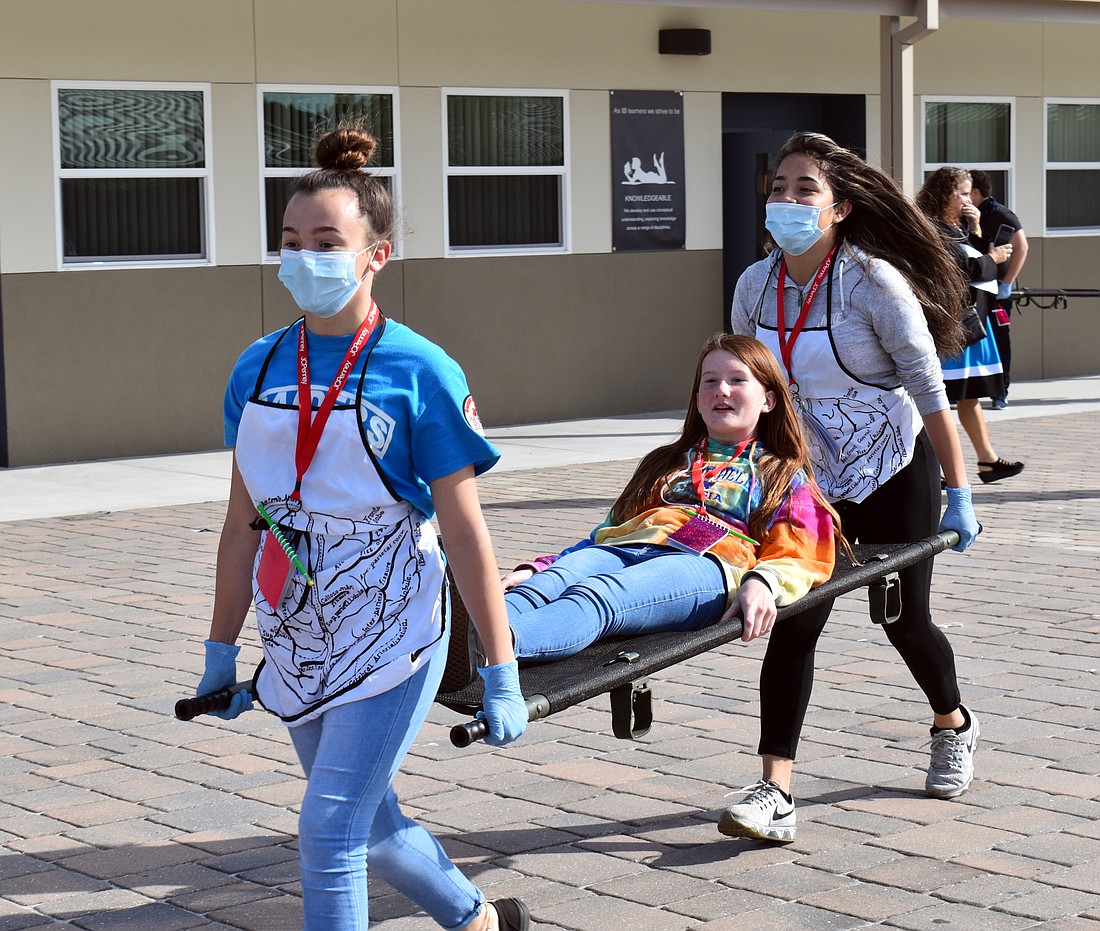- December 17, 2025
-
-
Loading

Loading

Time of death: 2:15 p.m.
The first victim to succumb to a pathogen that spread throughout Sarasota Military Academy Prep was just 14 years old. And although her passing was simulated, along with the rest of the daylong project for middle schoolers Dec. 5, the stress and lessons were real.
Just ask fellow students in a triage center who watched as classmates dressed as mortuary workers carried the girl away. Minutes earlier, she had reported a high fever, body aches and difficulties breathing. Less than two hours later, more than 60 other students were similarly afflicted.
“He’s infected; he’s infected,” one student yelled. “I’m out of here. I’m separated from my family, and I’m scared.”
Although the theatrics ran high, as they often do with middle school students, the simulation was designed to teach students about the civic and health processes of a pandemic. Students learned what it’s like to be a government employee, health official or member of the general population during an outbreak and how quickly things can turn sour.
The simulation’s milestones kept getting grimmer. About 30 minutes in, health workers were overburdened. Fights broke out. The military shot a student … albeit with a Nerf gun.
Epidemiologists worked to find a vaccination for the pathogen, which they thought could be swine flu or bird flu. Media members tried to get information to the students, with varying results. Government officials divvied up $300 million to different health organizations while cognizant of saving enough to produce a vaccine.
In the end, 38 of the 196 students died. The disease was ultimately found to be severe acute respiratory syndrome.
The exercise spun from and was transmitted through an app created by researchers at the Broad Institute of MIT and Harvard and Sabeti Lab, as part of a learning module, Operation Outbreak, created by SMA’s Todd Brown.
In the weeks leading up to the simulation, students participated in civics and science classes focusing on outbreak response and the roles clinicians, epidemiologists, government officials, media, military and the general population play. Throughout the simulation, students answered questions to earn money to be able to feed themselves and their families. If they experience symptoms, they report to a triage center.
Patient symptoms are reported to epidemiologists who try to figure out what the disease is and work to develop a vaccine. Military members try to keep order. All the while, media members try to deliver reliable information.
“It’s student-led and student-driven,” said Maj. Lisa Currie, the assistant head of SMA Prep. “It’s putting them in a position to have to be adaptable, flexible, spontaneous, problem-solving, creative — all of those good skills come up during this experiment.”
Kelly Cordeira, an epidemiologist at the U.S. Centers for Disease Control and Prevention and Patient Zero for the outbreak, watched it unfold.
“Students were learning and using skills like those of CDC disease detectives, such as teamwork, communication and rapid decision-making,” Cordeira said. “The simulated outbreak exercise gives students valuable hands-on experience [and] makes them more informed citizens. And perhaps, some will go on to become CDC disease detectives.”
Kai Rhodes, who “died,” said he was struck by the loss of control.
“I was infected while I was buying food, and within a few minutes I was dead,” Rhodes said. “I actually died while waiting to get help in the triage center.”
The simulation provides students the chance to reflect on how different decision-making processes can affect an outbreak. Giselle Martinez worked as a government official, which she said was stressful. Throughout the simulation, Martinez had to decide what organizations to fund, give orders to the military and give interviews to the media.
“It was really hard,” Martinez said. “I was rushed with every decision I had to make, and I had to give answers to everyone quickly because everyone was getting sick.”
Martinez, who is considering a government job as a future career path, said she also learned how the media could affect a situation.
During the outbreak, the student-led media posted a video that said the government had found a vaccine and was vaccinating government officials before giving it to the population.
“That just wasn’t true, and it was making people unnecessarily mad at us,” Martinez said.
Even though the students didn’t end up figuring out what the disease was, Martinez said she still felt the project was a success because less than 50% of the population died.
Scott Michael, a biology professor at Florida Gulf Coast University, monitored the outbreak to see if it’s something he could take back to his students.
“It’s fantastic because it teaches students about infectious diseases and all the pieces that go into controlling an outbreak, and it teaches them about the collaboration and communication it takes to combat something this large,” Scott said.